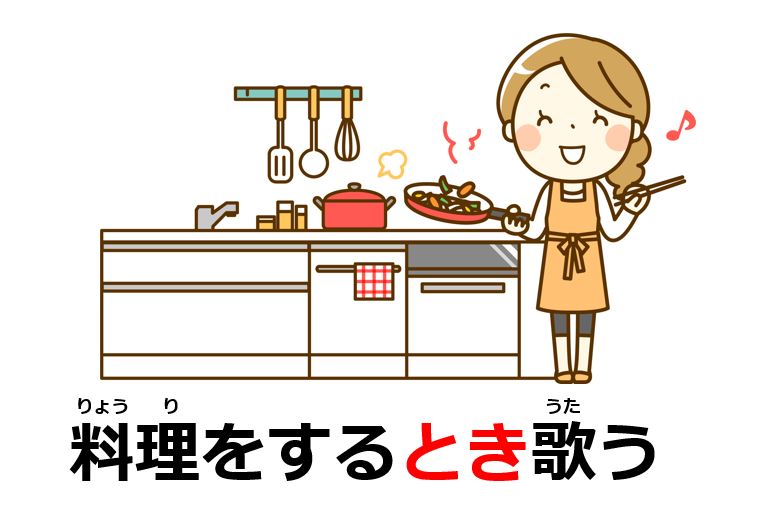Last time, you learned how to express simultaneous actions, e.g. “テレビを見ながら勉強をしました (I studied while watching TV).” The variety of your expression is greatly increasing now. Then, if you would like to say, “when I was a child, I studied while watching TV,” what should you do? In this lesson, you will learn how to utilize time clauses.
Explanation for How Time Clauses Work in Japanese
| Table of Contents とき and ときに: When …後で and …てから: After …前に: Befor あいだに: One-Time Actions within a Specific Period |
Time clauses are types of subordinate clauses, e.g. “when I got up” and “before I went to bed.” You can express more various things by using time clauses because you can set anything as a subject, whereas simultaneous actions require the same subject in main actions and sub actions. Let’s learn how it works.
とき and ときに: When
| 私が困っていたとき、 | 兄がいつも助けてくれ(た / ました) |
| Time Clause | Main Clause |
| When I was in trouble, my elder brother always helped [me]. | |
とき is grammatically a noun ”時: time” and written in Hiragana or Kanji. By using relative clauses with とき, you can express time clauses like “when” in English. Thus, you can directly connect sentences to とき without using conjugations. When you connect nouns and na-adjectives, you can also use の instead of the state-of-being style, e.g. 学生のとき VS. 学生だったとき. There is a certain difference in nuance between とき and ときに. When you use とき, main clauses should indicate habitual actions, ongoing states, and constant states.
| 学生のとき、祭りが好き(だった / でした)。 When [I] was a student, [I] liked festivals. |
| 子供だったとき、よくポケモンをして(いた / いました)。 When [I] was a child, [I] often played Pokemon. |
When it comes to ときに, the に comes from the particle に which indicates specific time. Therefore, when you use ときに, main clauses should indicate non-habitual actions or one-time events.
| 学生のときに、自転車で旅行(した / しました)。 When [I] was a student, [I] traveled by bicycle. |
| 地震が来たときに、泣いて(しまった / しまいました)。 [I] (unintentionally) cried when the earthquake came. |
Since it is a relative clause with a noun, you can substitute other words which have similar meanings to とき. For example, you can use “頃: (approximate) time” which indicates a wider range of time than とき.
| 学生の頃、祭りが好き(だった / でした)。 |
| 学生の頃に、自転車で旅行(した / しました)。 |
Considering both of the characteristics, if time clauses indicate actions which take place within a short time, とき is more suitable than 頃 and vice versa. Take a look at the following comparison.
| 地震が起きたときは、火を使ってはいけ(ない / ません)。 => Natural (As for when earthquakes happen, you must not use fire.) |
| 地震が起きた頃は、火を使ってはいけ(ない / ません)。 => Wrong |
| 学生のとき、祭りが好き(だった / でした)。 => Natural |
| 学生の頃、祭りが好き(だった / でした)。 => More natural |
[adsense]
…後で and …てから: After
| メールを送った後で、 | 間違いを見つけ(た / ました) |
| Time Clause | Main Clause |
| [I] found a mistake after [I] sent the email. | |
後で and てから are the counterpart to “after” in English. Regarding the conjugation, you attach the ta-form to 後で and the te-form to から. Only 後で allows you to connect nouns by placing の, i.e. “試合の後で: after the game.”
| ひらがなを勉強した後で、漢字を勉強(する / します)。 After [I] have studied Hiragana, [I] will study Kanji. |
| 田中さんが来てから、鈴木さんが(来た / 来ました)。 After Tanaka-san came, Suzuki-san came. |
| 昼ご飯の後でコーヒーを(飲んだ / 飲みました)。 After lunch, [I] had a cup of coffee. |
The difference between 後で and てから is this: 後で just expresses a sequence of actions while てから puts priority on the first action. With the following examples, てから is more suitable than 後で because the first actions are indispensable for the second actions.
| 辞書を買ってから、勉強を始め(よう / ましょう)。 Let’s begin studying after [we] have bought a dictionary. |
| 風邪が治ってから学校に来なさい。 Come to school after [you] have recovered from the cold. |
If main clauses indicate ongoing actions or states, or constant states, you have to drop the で from 後で. In the following comparison, 後 is more suitable because the second action is a progressive tense.
| 昼ご飯の後で、しばらく寝て(いた / いました)。 => Unnatural |
| 昼ご飯の後、しばらく寝て(いた / いました)。 After lunch, I was sleeping for a while. |
Japanese grammar guidebooks usually teach learners 後で, however, native speakers also use 後に in everyday life. The difference is still under discussion among linguists. It is said that when you use 後に, the relation or time between the first action and second action is closer than when using 後で. With the below examples, 後に is more natural because it is a kind of set action for Japanese culture to sequentially greet and bow.
| 日本人は挨拶をした後でおじきをする。 => Natural, but a little less than below |
| 日本人は挨拶をした後におじきをする。 Japanese people bow soon after greeting. |
You can use 後で (Not 後に) as a adverb like “later” and “afterward.” This is not involved with time clauses, but you should know the usage.
| 後で洗濯(する / します)よ。 [I] will do washing later. |
| 後で一緒にご飯を食べ(ない / ませんか)? Won’t [you] eat a meal with me later? |
…前に: Before
| メールを送る前に、 | 間違いを見つけ(た / ました) |
| Time Clause | Main Clause |
| [I] found a mistake before [I] sent the email. | |
前に is the counterpart to “before” in English. Regarding the conjugation, you attach the plain form to 前に (Be careful; verbs with 後で has to be in the ta-form). 前に allows you to connect nouns by placing の, i.e. “試合の前に: before the game.”
| 遊ぶ前に宿題を(する / します)。 Before [I] hang out, [I] will do my homework. |
| 先生が来る前に弁当を食べ(た / ました)。 Before the teacher came, [I] ate lunch. |
| 試合の前に練習を(しよう / しましょう)。 Let’s practice before the game. |
If the second action indicates ongoing actions or states, or constant states, you have to drop the に of 前に.
| 試合の前、練習をして(いた / いました)。 [I] was practicing before the game. |
| 田中さんに会う前、田中さんが怖かった(です)。 [I] was afraid of Tanaka-san before [I] met him. |
You can use 前に as an adverb likewise to 後で. This is not involved with time clauses, but you should know the usage.
| 前に日本へ行ったことが(ある / あります)。 [I] have been to Japan before. |
| 前に鈴木さんに(会った / 会いました)。 [I] met Suzuki-san before. |
あいだに: One-Time Actions within a Specific Period
| 親が電話をしているあいだに | 風呂に(入った / 入りました) |
| Time Clause | Main Clause |
| While [my] parent was on the phone, [I] took a bath. | |
あいだに indicates one-time actions within a specific period like “while” and “within.” Regarding the conjugation, you directly connect verbs which can last for a while like progressive tense and constant states. When you use nouns and na-adjectives, you can also use の instead of だった, i.e. 夜のあいだに VS. 夜だったあいだに. Note: あいだ is sometimes written in Kanji like this 間.
| 先生がいない間に昼寝を(する / します)。 [I] will take a nap while the teacher is not there. |
| 子供が寝ている間にご飯を(作った / 作りました)。 While [my] child was sleeping, [I] made a meal. |
| 夜のあいだに雨が(降った / 降りました)。 It rained in the night. |
If main clauses express ongoing actions or states, or constant states, you have to drop the に from あいだに.
| 先生がいない間、自習して(いた / いました)。 [I] was teaching myself while the teacher was not there. |
| 子供が寝ている間、ご飯を作って(いた / いました)。 While [my] kid was sleeping, [I] was making a meal. |
| 夜のあいだ、雨が降って(いた / いました)。 It was raining during the night. |
There is a similar sentence pattern: …うちに. This can express almost the same thing as あいだに. However, you need to pay attention to relations between time clauses and main clauses. Only when time clauses are necessity conditions for main clauses, you can use うちに.
| 子供が寝ているうちにご飯を(作った / 作りました)。 => Natural |
| 夜のうちに雨が(降った / 降りました)。 => Unnatural |
The background behind the first example above is something like the mother has to look after the kid when he/she is awake. Thus, the time when the kid was sleeping is the necessity condition for making a meal. Note: うちに doesn’t have the usage to drop に.
Summary
| Habitual Actions, Ongoing Actions, Ongoing States, and Constant States | One-Time Actions |
|---|---|
| とき | ときに |
| 後 | 後で / 後に |
| 前 | 前に |
| あいだ – |
あいだに うちに |
If you look at the above chart, you can easily figure out the differences. The particles are the key. The words without the particles requires you to use the one that indicates habitual actions, ongoing actions, ongoing states, or constant states. However, Japanese people may not strictly follow this grammatical rule. Please consider the rules as a basic knowledge to make natural sentences. Next, you will learn how to express reasons and purposes.





